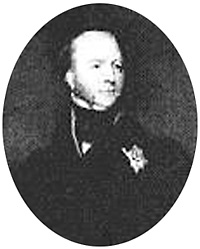
Genesee Country Magazine
Greatest Hits
Search Our Website!
 |
Genesee Country Magazine | Search Our Website! |
Related
Links: | GC Magazine Home | GC Greatest Hits | Clarion Publications | WNY Travel Guide |
The Other Hartford HouseDigging out the British roots of a very American home
|
 |
Francis Seymour-Conway, the 3rd Marquis of Hertford. |
After her death the influence of her eldest brother Edward Seymour, now an uncle to the future King grew immensely. Henry first made him Earl of Hertford, then Duke of Somerset and drew him into his closest circle of advisors. It is said that when Henry died in 1547, the Duke colluded to keep the death a secret until he was able to change the terms of Henry's will such that he would be made Lord Protector of the Realm during his nephew's minority.
There followed a series of royal intrigues in which Edward first executed his own brother, who had married Henry's widow, and then found himself at the receiving end of the ax. Despite that, the family had managed to greatly enrich itself through its royal connections and now included in its holdings the Berry Pomeroy Castle in Devon. For many generations the male Seymour heirs took the title of Baronet of Berry Pomeroy.
The fourth such Baronet, Edward Seymour married Letitia Popham, heiress to the prominent Conway family. When he died in 1708, he was succeeded by his son Francis, who, under a stipulation in his father's will, extended the family name in deference to his mother's lineage. Thus the name Seymour-Conway came into existence.
Francis Seymour-Conway became a member of both the British and Irish peerage, taking the titles of Baron Conway of Ragley and Baron Conway of Killiltagh. He was appointed Governor of Carrickfergus in Ireland, a position he held when he died.
His son, also named Francis, inherited the title of Baron Conway on his father's death in 1731. In 1750, he was created Earl of Hertford and from 1751 to 1766 he served as Lord of the Bedchamber for both George II and George III. He later became Viceroy of Ireland and finally Lord Chamberlain, the royal household's head of management. About a year before his death in 1794, the Baron was rewarded for his long service by being made the 1st Marquis of Hertford.
 |
This clock and bell tower at St. Dunstanıs Church in London were moved to the Marquisıs Villa about 1825 thus giving the house itıs name. It was returned to the church again around 1935. The mythical figures of Gog & Magog can be seen striking the bells. In British folklore, they were said to be the survivors of a race of giants destroyed by Brutus, the legendary founder of Britain. Photo by Philip Basham. |
Incidentally, the Marquis's younger brother, Henry Seymour-Conway, became well-known in America for his opposition to the oppressive Stamp Act while serving as British Secretary of State. He temporarily retired from politics in 1768, but remained a vociferous critic of the government's North American policies. He eventually returned to Parliament where he condemned Britain's role in the Revolutionary War winning many friends in the colonies. The village of Conway, Mass. was named in his honor, as was Conway, New Hampshire.
The 2nd Marquis of Hertford was perhaps most famous as a cuckold. His second wife, Isabella held the title Marchioness of Hertford, but scandalized proper society by carrying on an open affair with the Prince of Wales.
The future George IV would reportedly call every afternoon at her home on London's Manchester Square to “take tea.” The 2nd Marquis managed to profit from this connection, however, when Isabella's influence yielded him the appointment of Lord Chamberlain in 1812.
The third Marquis, Francis Charles Seymour-Conway, the hero (or villain) of our story, was born in 1777. At the age of 21 he married Maria Emily Fragnani who was the illegitimate daughter of the Marchesa Fragnani.
Maria was a very rich young woman. Two men, the
Duke of Queensberry and his friend George Selwyn each thought he was her father.
In those days before paternity tests, both men lavished her with sizable amounts
of money and each left her a considerable fortune in his will.
According to WebCounter
you are the
person to answer the Clarion Call
©2008 Clarion Publications, Inc. All
Rights Reserved.
This site designed by Clarion Communications.